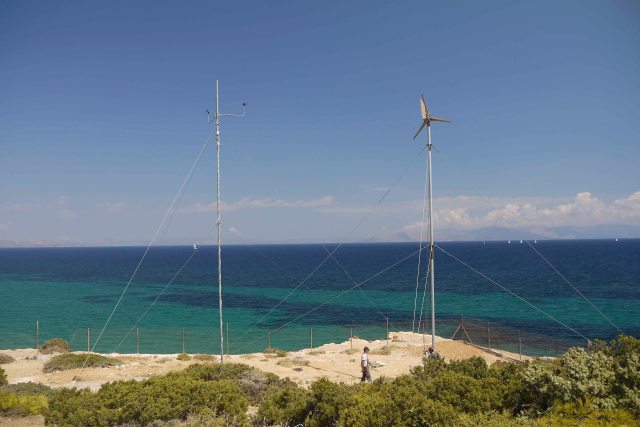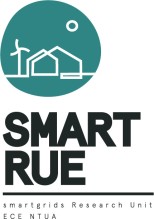Test site in the coastal summer camp of ‘Meltemi’ in Rafina, Attika
The small wind turbine test site in Rafina allows for outdoor measurements of the power and energy production of household small wind turbines for grid connected and battery charging applications. The facilities of the test site are in accordance to the IEC international standard IEC 61400-12-1: Power Performance Measurements of electricity producing wind turbines, and specifically of Annex H which refers to small wind turbine testing. With the use of the standard one can plot the power curve, the system’s power coefficient Cp and also predict the annual energy production of the turbine for different mean wind speeds. Further, the appropriate manner of installing meteorological and electrical sensors, the way to analyze logged data and the way that they are to be presented, are all determined as well as the procedure for estimation of uncertainties.
The test site’s infrastructure allows for the installation and testing of small wind turbines ranging from 1.2m to 7.6m rotor diameter in off-grid (battery charging) or grid tied operation. The wind turbines are installed at a hub height of 12m above ground on a galvanized metal tower of appropriate diameter and thickness, while the tower is supported by two sets of guy ropes (one at 6m and another at 12m) with four galvanized steel ropes in each set, at an angle of 90 degrees between each one. The guy ropes are safely anchored to concrete blocks at ground level. The specifications of the steel wire ropes and of the concrete blocks are such as to withstand wind gusts of up to 40m/s when the largest 7.6m rotor diameter small wind turbine is facing the wind.
For the collection of the necessary meteorological data the following sensors are used, Table 1, which are placed on a separate meteorological mast, 9m away from the installed small wind turbine. The positioning of the sensors is specified in the IEC 61400-12-1 standard, while the horizontal positioning of the anemometer is determined by the rotor diameter of the small wind turbine under test and can be adjusted accordingly.
|
Sensor type |
Model / Serial No |
|
|
1. |
Anemometer (primary) |
VECTOR A100LK |
|
2. |
Anemometer (control) |
NRG-40C |
|
3. |
Wind Vane |
NRG-200P |
|
4. |
Temperature |
NRG-110 |
|
5. |
Pressure |
NRG-BP-20 |
|
6. |
Humidity |
NRG-RH-5 |
Table 1: Meteorological sensors
For the collection of the necessary electrical data the following sensors are used, Table 2, and are placed close to the turbine’s load. Three AC voltages and AC currents are logged before the rectifier, with the ability to also measure revolutions per minute (RPM) through the AC signal frequency. After the rectifier, the DC voltage and DC current flowing in the battery bank are recorded for battery charging applications or the DC voltage and DC current flowing through the grid-tie inverter for grid connected applications. In this way the power curve of the turbine can be plotted along with all other relevant data, including losses in the cable connecting the turbine to its load, while the distance of the turbine to the load meets the standards set by IEC 61400-12-1. All sensors are calibrated once every year and fulfill the accuracy requirements of IEC 61400-12-1.
|
Sensor type |
Model / Serial No |
|
|
1. |
Phase R (voltage AC) |
LV25-P |
|
2. |
Phase S (voltage AC) |
LV25-P |
|
3. |
Phase t (voltage AC) |
LV25-P |
|
4. |
Voltage DC |
LV25-P |
|
5. |
Phase R (current AC) |
CSNR151 |
|
6. |
Phase S (current AC) |
CSNR151 |
|
7. |
Phase T (current AC) |
CSNR151 |
|
8. |
Current DC |
CSNR151 |
Table 2: Electrical sensors
Data is logged through LabView software and the NI 6225 data acquisition card of National Instruments. Logged data are stored locally on a PC and sent at the end of each day to the SmartRue data base in NTUA. Further on, real time data observation is possible on site or remotely. The ‘Wind Turbine Performance Data Analysis Tool’ developed by SmartRue lab, is a data management tool that allows for in depth analysis of the measurements, either in the per second raw data format or in one minute averages. This enables the user to observe the small wind turbine in small time periods e.g. of a few seconds in order to study its behavior in wind gusts, while at the same time, using one minute averages, large amounts of data can be processed, in order to calculate the power curve etc.







